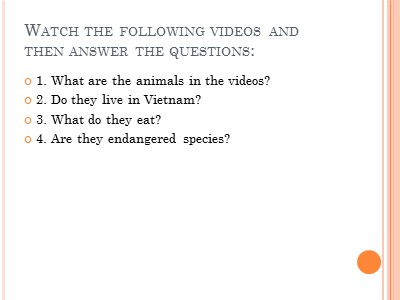Bài giảng môn Tiếng Anh Khối 12 - Unit 6: Endangered species - Lesson 6: Writing

TASK 1. Match the pictures with the animals' names. Then discuss the questions with a partner.
1. b (Komodo dragon: not found in Viet Nam; eats meat; classified as vulnerable)
2. a (blue whale: sometimes found stranded on Viet Nam's coastal areas; eats small shellfish; classified as endangered)
Bạn đang xem tài liệu "Bài giảng môn Tiếng Anh Khối 12 - Unit 6: Endangered species - Lesson 6: Writing", để tải tài liệu gốc về máy bạn click vào nút DOWNLOAD ở trên
Watch the following videos and then answer the questions:1. What are the animals in the videos?2. Do they live in Vietnam?3. What do they eat?4. Are they endangered species?Video 1VIDEO 2answer the questions1. What are the animals in the videos?They are a blue whale and a Komodo dragon.2. Do they live in Vietnam?No, they don’t.3. What do they eat?Komodo dragons eat meat.Blue whale eat very small shellfish.4. Are they endangered species?Komodo dragons are vulnerable and blue whales are endangered.unit 6: Endangered species Lesson 6: writingTASK 1. Match the pictures with the animals' names. Then discuss the questions with a partner. 1. b (Komodo dragon: not found in Viet Nam; eats meat; classified as vulnerable) 2. a (blue whale: sometimes found stranded on Viet Nam's coastal areas; eats small shellfish; classified as endangered) b. Komodo dragon (rồng Komodo)a. blue whale (cá voi xanh)TASK 2: Read the facts about the Komodo dragon and the blue whale. Write a, b, c, d, or e in the space provided to match the title with the correct section. TASK 2: Read the facts about the Komodo dragon and the blue whale. Write a, b, c, d, or e in the space provided to match the title with the correct section. 1. Habitat and location Komdodo dragon (Rồng Komodo)- found in the wild on Indonesian islands (Komodo, Rinca, Gili Montang, Gili Dasami, Flores) - live in forests, on beaches, on hilltops Blue whale (Cá voi xanh)- live in the cold waters of the Arctic and Antarctic - migrate to tropical seas to breed (up to four months) 2. Physical features Komdodo dragon - looks like a crocodile or lizard - male adults can grow up to 3 metres long Blue whale - mammal, but looks like a fish - 30 metres long; - 150-200 tons 1. c2. e5. Conservation status Komdodo dragon - vulnerable (IUCN Red List) - cause: more males than females (humans are not a threat) - protected by anti-poaching laws in Indonesia and by 30 zoos and other wildlife parks outside Indonesia Blue whale - endangered (IUCN Red List) (nguy cấp (Danh sách đỏ IUCN)- facing threats from whalers, pollution, collisions with boats and ships, and global warming ; - many recovery plans to restore its population 3. Diet Komdodo dragon -eat meat (large water buffaloes, deer, pigs, smaller dragons) Blue whale -eat very small shellfish (ăn sò ốc rất nhỏ)4. PopulationKomdodo dragon -6,000 in the wild in Indonesia; slightly declining Blue whale -estimated 14,000 (10,000 in the Antarctic and 4,000 in the Arctic); increasing 3.a4.d5.bParagraph 1: Habitat and location of the species below.Example: Komodo dragons are found in the wild They live in forests, Paragraph 2: Physical features and dietExample: Although they are called dragons, they look like Paragraph 3: Population and conservation statusExample: There are about 6,000 According to the IUCN Red List, Komodo dragons are classified as TASK 3. Choose one of the two species in 2 and write a report of 150-200 words to describe it. Follow the plan below. Komodo dragons are found in the wild on only (1)______islands in (2)_______: Komodo, Rinca, Gili Montang, Gili Dasami and Flores, where they roam freely. They live mainly in (3)_______, but can be seen scattered widely over the islands from beaches to hilltops. Though they are called dragons, they look like big (4)_______. A male adult can (5)_______to 3 metres long and weighs (6)_______ kilos. Komodo dragons eat (7)______ They are also fierce hunters and can eat very large prey, such as large water buffaloes, deer and pigs. They will even eat smaller (8)_______.There are about (9)_______Komodo dragons in Indonesia. Humans are not a great danger to them. However, their population is slightly declining because there are more (10)_______ than females. According to the IUCN Red List, Komodo dragons are not endangered, but are considered vulnerable. About (11)_______ zoos outside Indonesia have been trying to protect the Komodo. There are also plans to build more (12)_______ parks around the world, which will help to increase the population of this fascinating species.FiveIndonesiaForestsLizardsGrow up90MeatKomodo dragons6,000Males30wildlifeKomodo dragons are found in the wild on only (1) five islands in (2) Indonesia: Komodo, Rinca, Gili Montang, Gili Dasami and Flores, where they roam freely. They live mainly in (3) forests, but can be seen scattered widely over the islands from beaches to hilltops. Though they are called dragons, they look like big (4) lizards. A male adult can (5) grow up to 3 metres long and weighs (6) 90 kilos. Komodo dragons eat (7) meat. They are also fierce hunters and can eat very large prey, such as large water buffaloes, deer and pigs. They will even eat smaller (8) Komodo dragons.There are about (9) 6,000 Komodo dragons in Indonesia. Humans are not a great danger to them. However, their population is slightly declining because there are more (10) males than females. According to the IUCN Red List, Komodo dragons are not endangered, but are considered vulnerable. About (11) 30 zoos outside Indonesia have been trying to protect the Komodo. There are also plans to build more (12) wildlife parks around the world, which will help to increase the population of this fascinating species.HOMEWORK+ Write a report about Blue WhaleTHANKS FOR ATTENTION!
Tài liệu đính kèm:
 bai_giang_mon_tieng_anh_khoi_12_unit_6_endangered_species_le.pptx
bai_giang_mon_tieng_anh_khoi_12_unit_6_endangered_species_le.pptx



